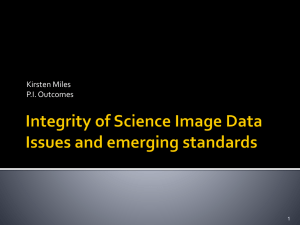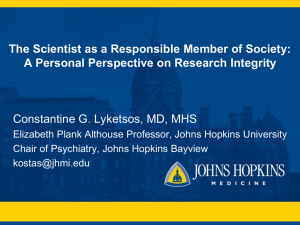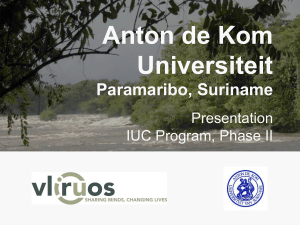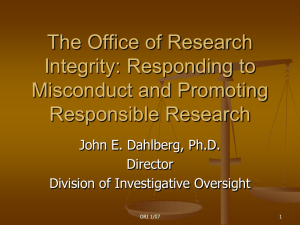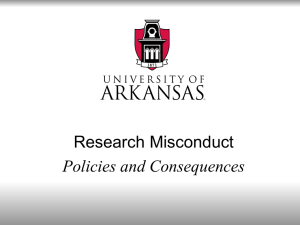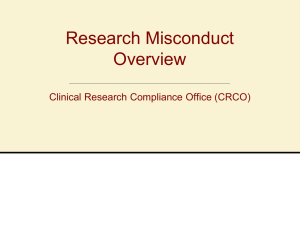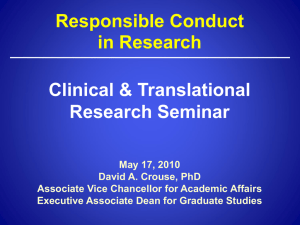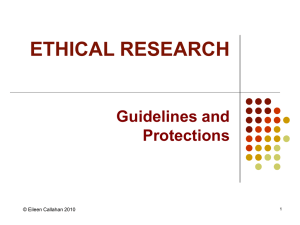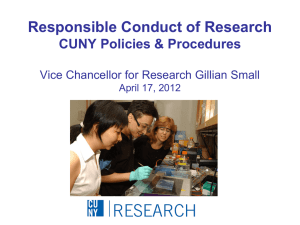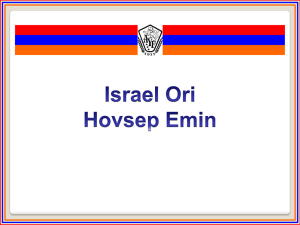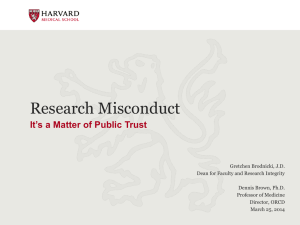Integrity in the Name of Research
advertisement
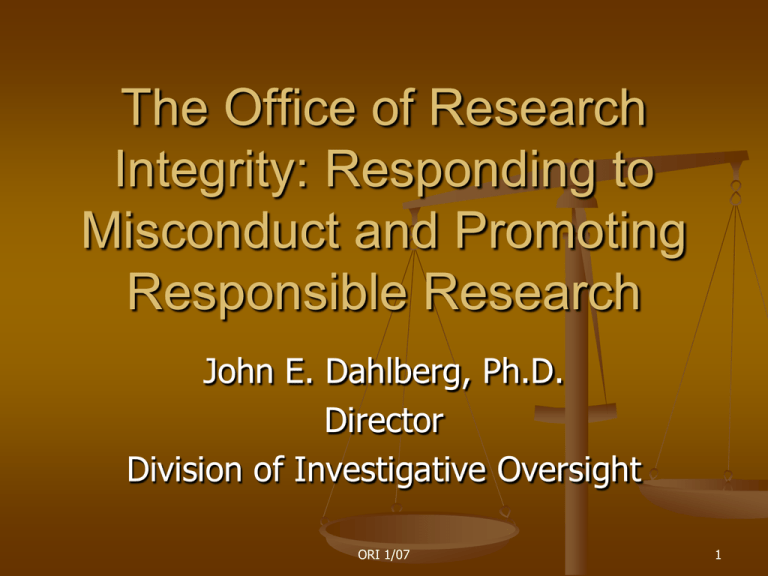
The Office of Research
Integrity: Responding to
Misconduct and Promoting
Responsible Research
John E. Dahlberg, Ph.D.
Director
Division of Investigative Oversight
ORI 1/07
1
ORI’s Mission
Mission: To promote the integrity of PHSsupported extramural and
intramural research programs
Respond effectively to allegations
of research misconduct
Promote research integrity
ORI 1/07
2
Definition of Research Misconduct
Fabrication is making up data or results
and recording or reporting them
Falsification is manipulating research
materials, equipment, or processes, or
changing or omitting data or results such
that the research is not accurately
represented in the research record
ORI 1/07
3
Definition of Research Misconduct
Plagiarism is the appropriation of another
person’s ideas, processes, results, or
words without giving appropriate credit
Research misconduct does not include
honest error or differences of opinion
(42 CFR Part 93.103)
ORI 1/07
4
Proof of Research Misconduct
Requires That there be a significant departure from
accepted practices of the relevant
research community, and
The misconduct be committed
intentionally, knowingly, or recklessly; and
The allegation be proven by a
preponderance of the evidence,
(42 CFR Part 93.104)
ORI 1/07
5
Additional ORI Activities
Administer the Assurance program, a
database of all institutions eligible to
receive PHS funds
Correct or retract research publications to
protect the integrity of the scientific
literature
Protect the confidentiality of respondents,
complainants, and witnesses
Protect witnesses from retaliation
(42 CFR 93.300 (d) )
ORI 1/07
6
ORI Activities (cont)
Provide education in RCR
Collaborate with the research community
to improve biomedical research
Exclude dishonest investigators from PHS
and Federal agency funded research
Make public findings of misconduct so that
institutions and individuals will be aware
of wrongdoing
ORI 1/07
7
ORI lacks jurisdictions for many
types of inappropriate behavior:
some are referred to other agencies
Misuse of human or animal subjects
Misconduct and other complaints
involving FDA-regulated research
Financial mismanagement
Radiation or biosafety hazards
Conflict of interest
ORI 1/07
8
Other issues not within ORI’s
jurisdiction:
Honest error or honest differences in
interpretations or judgments of data
Authorship or credit disputes
Duplicate publication
Collaboration agreements or researchrelated disputes among collaborators
Intellectual property
ORI 1/07
9
Issues not within ORI’s jurisdiction
(Continued)
Laboratory management
Quality control/quality assurance (eg.,
surveillance data)
Employment issues such as job changes,
promotion, termination, salary, etc.
Disputes over space, equipment access,
collaborative work
ORI 1/07
10
Research Misconduct in
Clinical Research
By policy, in clinical trails, certain types of falsifications are
not handled by ORI as allegations of research misconduct.
These include:
Falsified or forged consent forms
Failure to report an adverse event to the IRB or sponsor
Protocol deviations such as entering ineligible subjects,
administering an off-protocol drug, forging a physician’s
signature on orders
Failure to obtain informed consent
Breach of patient confidentiality
Failure to obtain IRB approval for changes to protocol
ORI 1/07
11
Research Misconduct in Clinical
Research, (Continued)
Behaviors that are considered research misconduct:
Falsifications:
Substitutions of one subject’s record for another’s
Changing research record to favor the study’s hypothesis
Altering eligibility dates and eligibility test results
Falsifying dates on patient screening logs
Fabrications:
Not conducting interviews with subjects and creating
records of the interview
Making up patient visits and inserting that record into the
medical chart
Recording the results of follow-up visits with deceased
subjects
ORI 1/07
12
Types of data that have been falsified
or fabricated in clinical studies
Interviews
Entry criteria
Screening logs
Approval forms
Follow-up
exams/data
Consent forms
Test scores
Laboratory results
Patient data
Number of subjects
Dates of procedures
Protocol
Study results
ORI 1/07
13
ORI’s Handling of Cases
Allegation – at institution or at ORI
Allegation Assessment – if at ORI, referred to institution
Institution Inquiry
Institution Investigation – institutional actions
DIO Review of Institution’s Investigation
ORI Director’s Decision on proposed administrative
actions
If misconduct, seek settlement or send charge letter
followed by hearing
If misconduct found, possible appeal
With final departmental finding, impose administrative
actions
ORI 1/07
14
Some ORI Statistics
1992 to July 2007 statistics:
Total misconduct findings
Misconduct findings that involve
clinical research
Findings leading to debarment
Total cases opened from 1992
Total cases closed from 1992
ORI 1/07
189
27%
119
501
531
15
Statistics (cont)
Total cases pending
Total allegations from 1992
Allegations per year
Retracted papers
Corrected papers
Withdrawn papers
Total of correct, retracted, and
withdrawn journal articles
ORI 1/07
43
3,084
~225
114
31
4
149
16
Major misconduct case:
Eric Poehlman, Ph.D.
University of Vermont
ORI 1/07
17
Initial Allegations
The initial allegations arose when Dr.
Poehlman provided a colleague, about a
week apart, two versions of a spreadsheet
containing physical, dietary, energetic, and
metabolic data on elderly men and women
seen twice, on average, about six years
apart.
In the complainant’s own words:
ORI 1/07
18
Initial allegations (cont)
The incident that triggered my suspicions
occurred in late September, 2000 - I was asked
by Dr. Poehlman to write a paper from a
longitudinal database (Protocol #678). The
paper was to examine the effects of age on
lipids in men and women… When I presented
him with the data, he was not satisfied with the
results and asked for the database in order to
verify data entries and check for what he
described as "reversed" datapoints, … It was my
belief that I was mistakenly given a “true”
version of the dataset originally and then given
the manipulated version the second time…
ORI 1/07
19
The Scope of the Misconduct
The following two slides provide a glimpse
of the massive scope of Dr. Poehlman’s
alterations in the data base for the
longitudinal study of aging, protocol #678.
ORI 1/07
20
Correct TEE values
Dr. Poehlman’s TEE values
Dr. Poehlman’s changes to total
energy expenditure values included
many fabrications (blue) and
reversals of visit one and visit two
values (red)
The net effects were to greatly
inflate the number of subjects and
to reverse the apparent effect of
aging.
ORI 1/07
21
Dr. Poehlman’s changes to
glucose involved near
complete reversal of T1 and
T2 values, allowing him to
claim that glucose levels
rose with age when the real
data showed the opposite.
ORI 1/07
22
Tip of the iceberg
The total number of reversals, falsifications and
fabrications made by Dr. Poehlman to the 467
database was greater than 4000, all in a small
fraction of the hundreds of fields of data.
Although he had reported data from this study
in three unfunded grant applications, almost
nothing was published, and the “harm done,” by
itself, was not extensive.
However, much more was subsequently
revealed….
Additional Issues
Dr. Poehlman claimed to have conducted a
longitudinal study of the menopause transition
involving 35 women seen twice six years apart.
This study was reported in a 1995 paper in the
Annals of Internal Medicine and five follow-up
papers as well as in many grant applications.
The study was not conducted: Dr. Poehlman
falsified the number of subjects at T1 and never
saw the women a second time.
ORI 1/07
24
The data from the Annals paper claimed to show that the
menopause transition quickly leads to undesirable
changes in weight, fat mass, resting metabolic rate,
leisure time activity, and waist-to-hip ratio.
None of these conclusions were legitimate (although
cross-sectional studies have suggested that changes do
occur eventually).
Additional fabricated results from this study were reported
in later papers and grant applications.
Additional Issues (cont)
The UVM investigation, ORI, and the U.S.
Attorney’s office determined that Dr. Poehlman
falsified data in additional papers and grant
applications in areas as wide ranging as
Alzheimer’s disease, the effect of endurance
training on RMR, and the effects of hormone
replacement therapy on post-menopausal
women.
Many of these false claims were also made in
talks given by Dr. Poehlman, some of which
were documented, allowing additional findings
of scientific misconduct to be made.
ORI 1/07
26
Dr. Poehlman’s obstruction efforts
Starting immediately after being accused of
misconduct, Dr. Poehlman aggressively
attempted to obstruct the University
investigation, and subsequently the
Government’s review.
He accused his young colleagues of having
falsified the 678 database.
He went to Federal court to attempt to block
UVM from notifying ORI of the pending
investigation.
ORI 1/07
27
Obstruction (cont)
During the investigation, he solicited letters of
support from collaborators and former
technicians who claimed that they had helped
with the longitudinal menopause study; these
claims resulted from Dr. Poehlman’s false
assurances and edits of the letters, and they
placed these witnesses in legal jeopardy.
Dr. Poehlman submitted falsified and fabricated
documents to the UVM committee in an effort to
show that the 35 women in the menopause
study had visited the GCRC a second time.
ORI 1/07
28
Why did it take so long to discover?
“The reality is that an established and
renowned principal investigator with this
volume of complex data could easily
generate and propagate false values for
months, even years, without anyone
catching on” (UVM Report, p. 19)
ORI 1/07
29
Summary
Dr. Poehlman falsified and fabricated data in
NIH grant applications and in published articles
over a 10 year period with NIH funding of
almost $3 million
Counting two USDA applications, he provided
falsified and fabricated preliminary data to
government agencies in 17 different competitive
and non-competitive applications.
Falsifications and fabrications were made in
applications worth over $11,000,000 if funding
would have been approved.
ORI 1/07
30
Summary
The misconduct affected studies related to
disease prevention, including research on the
health of older men and women, the effect of
diet, exercise, menopause status, hormone
replacement, and disease status.
The University of Vermont made 22 findings of
scientific misconduct in areas represented by 3
GCRC protocols.
ORI confirmed 21 of the findings made by UVM
and made 35 additional findings in the same
plus 2 additional areas ( 5 protocols).
ORI 1/07
31
The role of the Justice
Department: ORI Assurance
Assurance on application form PHS 398, #15
Principal Investigator/Program Director
Assurance: I certify that the statements herein
are true, complete and accurate to the best of
my knowledge. I am aware that any false,
fictitious, or fraudulent statements or claims may
subject me to criminal, civil, or administrative
penalties. I agree to accept responsibility for
the scientific conduct of the project and to
provide the required progress reports if a grant
is awarded as a result of this application.
ORI 1/07
32
This is what led to Dr.
Poehlman pleading
guilty to a felony
ORI 1/07
33
What Was the involvement of the
Vermont U.S. Attorney
Defended civil litigation brought by Dr.
Poehlman to prevent mandatory reporting of
misconduct investigation to ORI
Opened civil and criminal fraud investigations
into Dr. Poehlman’s research activities, assisted
by ORI and HHS OIG
Decided that false claims of Dr. Poehlman
warranted a criminal charge and personal
monetary settlement of $180,000
Dr. Poehlman sentenced to jail term of one year
and a day based on admission to one felony
count and ordered to a federal prison work
camp in Maryland
ORI 1/07
34
ORI actions and the
Whistleblower’s role
ORI/ASH actions against Dr. Poehlman
include lifetime debarment from Federal
research funding and retraction/correction
of ten published papers
The whistleblower in this case later filed a
qui tam suit under Federal fraud laws and
received a relator’s share of 12%
($22,000) of the Federal recovery of
$180,000
ORI 1/07
35
Impact of Dr. Poehlman’s Actions
in the Scientific Community
Millions of dollars in Federal grant money
have been mis-spent.
The careers of Dr. Poehlman’s students
and collaborators have been damaged or
impaired.
Other researchers have wasted their time
and laboratory resources trying to
reproduce and extend the false claims
made by Dr. Poehlman.
ORI 1/07
36
Impact of Dr. Poehlman’s Actions
on the General Public
Dr. Poehlman’s research attempted to identify
ways to modify life style to lengthen life and
improve its quality.
The loyal and dedicated volunteers in the
Vermont community felt betrayed and may be
reluctant to continue volunteering for studies at
UVM.
Dr. Poehlman’s actions had a negative impact on
the level of trust in science for health care
consumers who rely on honest research results
for improved health care.
ORI 1/07
37
Lessons Learned
Research misconduct can go undetected for
years, even when the misconduct is massive
A determined cheater can mislead collaborators
indefinitely
Institutional commitment and careful adherence
to policies and procedures are needed for
successful investigations
ORI and the research community rely heavily on
honest scientists in the lab to come forward with
evidence of misconduct
ORI 1/07
38
DIO Oversight: Forensics
During the 20 years that OSI/ORI have existed,
investigators have developed a number of
computer-assisted tools and approaches to help
strengthen institutional findings.
The following slides will provide a few examples
of this.
Detection of Fabricated
Numbers
If sets of transcribed numbers are provided as
“raw data” rather than instrument printouts,
consider whether the numbers might have been
fabricated.
Research by ORI and others shows that
insignificant (right-most) digits in numbers, if real,
e.g. from instruments, are uniformly distributed
while numbers made up by people often are nonuniform.
ORI 4/05
40
Here is a DIO scan of a
spreadsheet submitted
by a respondent that
was unaccompanied by
an instrument printout.
Under pressure, he
subsequently provided
similar data that was
accompanied by
printouts from a
scintillation counter.
ORI 4/05
41
The tool used by DIO
ORI 4/05
42
The DigiProbe Screen
Start with the numbers copied into a text file
ORI 4/05
43
Bar graphs effectively illustrate the distribution of digits for
the two right most positions for the data sets without
counter tapes (left) and those with counter tapes
(right).
Data Sets 1-3 (no counter tapes)
Data Sets 4-11
Right-most digit; p = < 0.00001
Second right-most (10s), p = <0.00001
70
60
60
50
50
Frequency
Frequency
40
40
30
30
20
20
Right-most digit; p = 0.778
Second right-most (10s), p = 0.787
10
10
0
0
0
1
2
3
4
5
Digit
6
7
8
9
ORI 4/05
0
1
2
3
4
5
Digit
6
7
8
44
9
DIO analysis of the distribution of the two right most digits in data sets 1-11
(group V)
Probabilities
obtained with
DigiProbe for
the 11 assays
and for the
assays with
and without
counter tapes
grouped
together.
Data set
Total Digits
p value
1
100, 100
<0.00001, <0.00001
2
156, 156
<.00001, 0.00002
3
156, 156
0.02519, 0.00451
4
56, 56
0.57784, 0.47087
5
42, 42
0.22426, 0.22426
6
78, 78
0.46860, 0.57069
7
93, 93
0.27719, 0.97832
8
74, 74
0.07906, 0.51789
9
77, 77
0.33904,0.40441
10
42, 39
0.19768, 0.24219
11
50, 50
0.81654, 0.77919
1-3
412, 412
<0.00001, <0.00001
4-11
512, 509
0.77754, 0.78696
ORI Cases With Questioned Images
80.0
70.0
60.0
50.0
40.0
30.0
20.0
10.0
0.0
1 2 3 4 5 6 7 8 9 10
2 Year Reporting Period ('89-90 to '07-08)
Examples of analyzing images
Several examples follow which illustrate how ORI
can examine images provided by institutions
during their investigation.
Many of ORI’s cases involve images that are
duplicated from paper to paper or paper to grant
application. This may be duplicate publication,
but when such images are said to be the result
of different experiments, one of the images, at
minimum, has been potentially falsified.
The first example, however, is a little different.
ORI 4/05
48
Screen shot from
Photoshop
showing analysis
under way – the
small circle in the
Color Picker is the
brush size moved
to a color
approximately
matching the
image’s
background.
ORI 4/05
49
The result of removing most of the “scribbling.”
ORI 4/05
50
Observations
The most compelling evidence for misconduct in this
case was obtained from the fabricated data sets not
examined by the university.
In no instance was the distribution of non-leading
digits non-uniform when tapes were available, and in
each of the three assays without tapes, digits were
non-uniform at both positions.
This conclusion is made significantly stronger by the
presence of “control data” from companion assays
for which counter tapes were available.
ORI 4/05
51
Moving to the digital age
The next examples illustrate the importance of
the eye to detect evidence of inappropriate
image manipulation.
In addition, many ORI cases rely on prompt
sequestration of evidence, including hard drives
and portable storage media, to ensure that
manipulated images can be shown to have
originated with a particular individual.
Time-date stamps are often probative with
respect to how and when the manipulations
occurred.
Moving to the digital age
The next examples illustrate the
importance of the eye to detect evidence
of inappropriate image manipulation.
In addition, many ORI cases rely on
prompt sequestration of evidence,
including hard drives and portable storage
media, to ensure that manipulated images
can be shown to have originated with a
particular individual.
Time-date stamps are often probative with
A Slippery Slope
The next few slides show how difficult it
can be to determine if a manipulation is
appropriate, possibly inappropriate, or
obviously fraudulent.
Generally, ORI is reluctant to make
findings of misconduct when an image has
been “beautified” by altering background,
or by reuse of loading controls, when the
actual data verifies the factual findings
claimed in the grant or paper.
However, adding or removing important
An example of unique images that alerted the
institution to apparent falsification. The original
images were of all positive or all negative cells
positive for a gene different from HIV DNA or
RNA.
How to detect non-obvious
changes
Some of the following slides will illustrate
how Photoshop can be used to help our
eyes visualize alterations to images, and
verify suspected duplications, through the
use of specific tools such as the gradient
map, contours, and various enhancements
such as contrast and intensity.
Principles/Methods
DETECTION
Increase Visibility of “Hidden” Details
Bulk of Falsified Images are ‘Blots’
Scope
of Falsified Images
rotated
rotated
duplicated
Portion of On-Line Journal Image
Note Multiple Inconsistencies
Examples
But It’s Not Just Blots
Author “tells”
us where
to look
Note: * denotes key metabolic gene
On-Line Journal Image:
Visualize with Gradient Map:
Increase contrast
Remap Intensities
Add False-Color
Methods
What can you do at your
institution?
You can help set the tone for the institution and
make integrity a high priority
As an administrator, you can develop and
implement policies that support integrity
As a principal investigator, you can establish
specific standards for your staff on recording,
retaining, reporting, and publishing data
As a junior scientist in the lab, you can make a
personal commitment to integrity and practice it
on a daily basis
ORI 1/07
66
Responsible Conduct of
Research (RCR)
What can ORI and institutions do
to help prevent research
misconduct?
ORI 1/07
67
The Nine Elements of RCR
1. Acquisition, management, sharing and ownership of
data
2. Conflict of interest and commitment
3. Research misconduct (plagiarism, falsification &
fabrication)
4. Publication practices and responsible authorship
5. Mentor/mentee responsibilities
6. Peer review
7. Collaborative scholarship
8. Human subjects
9. Animal subjects
ORI 1/07
68
RCR at the Individual Level
encompasses:
Intellectual honesty in proposing,
performing, and reporting research
Accuracy in representing contributions
Fairness in peer review
Transparency in conflicts of interest
ORI 1/07
69
RCR at the Individual Level also
entails:
Assuming personal responsibility for
avoiding or managing conflicts
Taking responsibility for protecting human
subjects and for the humane care of
animals
Appropriately recording research results
and retaining research records
Careful and thoughtful mentoring of
students and junior scientists
ORI 1/07
70
How can RCR be implemented
at the institutional level?
Provide leadership in RCR
Facilitate productive interactions between
trainees and mentors
Advocate adherence to rules regarding the
conduct of research
Provide training to both mentors, junior
scientists, and students tailored to their
respective needs
ORI 1/07
71
RCR at the Institutional level (cont.)
Conduct inquiries and investigations into
alleged misconduct
RCR training should include discussions of
misconduct cases and their adverse
consequences to respondents
Consider publicizing your cases (suitably
redacted) to ensure that staff realize that
you take misconduct seriously and act on
allegations
ORI 1/07
72
A few key issues that DIO has found
contribute most significantly to allowing
misconduct
1. Inadequate record keeping and lack of
guidance from mentors on how to record and
retain research data;
2. Failure of mentors to regularly review raw
data; overreliance on derivative data
(PowerPoint presentations) at lab meetings
3. Unquestioning acceptance of data that others
consider “too good to be true”
ORI 1/07
73
More issues that facilitate misconduct
4. Lack of transparency within the laboratory and
among the staff
5. Labs so large that authority becomes diffuse
6. P.I.s are spread too thin, and do not provide
adequate training and guidance to students
The bottom line – good mentorship and the constant
review of raw data can profoundly reduce the
likelihood of a mentee committing research
misconduct.
ORI 1/07
74
ORI can provide assistance
240 453 8800; AskORI@hhs.gov
Telephone or on site assistance available
Allegation assessment
Advice on policies and procedures, for example :
Sequestration of evidence
Acquisition of digital information (forensic imaging of
hard drives)
Properly getting an inquiry or investigation under way
Analysis of the evidence, such as assisting with analysis
of questioned images
Investigative strategy and legal problems
ORI 1/07
75
Conclusion
DEVELOP AN RCR PROGRAM THAT
WORKS FOR YOU!
http://ori.hhs.gov
ORI 1/07
76
